By Sanjay Joshi
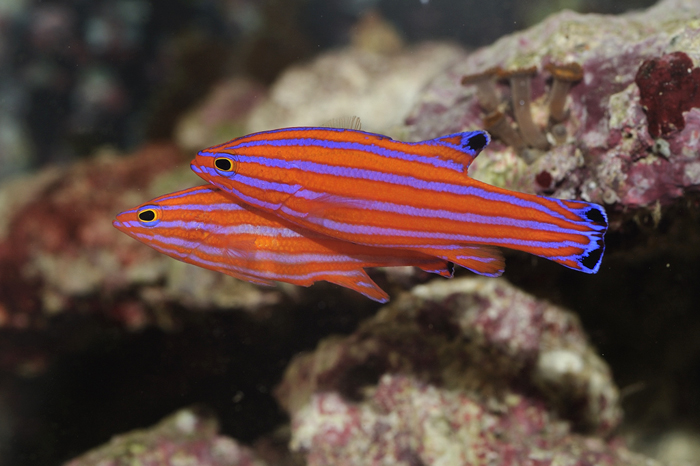 The Candy Basslet (Liopropoma carmabi) has long been one of my favorite fish ever since I saw one in my friend Greg Schiemer’s tank several years ago. Greg also wrote a nice article about these fish in Advanced Aquarist (http://www.advancedaquarist.com/2006/10/fish ) in 2006. Since then it’s been in the back of my mind as one of my “Holy Grail” fish that I would not easily find or be able to acquire. More recently Kevin Kohen wrote another great article about these fish in Reef Life magazine accompanied by some spectacular pictures. The fish started to show up on Live Aquaria Diver’s Den often as singles, but also occasionally as pairs. This renewed the dreams and desire once again, this time with the possibility of the dream becoming reality. More recently, I have been trying to keep fish in pairs or trios in my 500G aquarium, whenever possible. This has been a really rewarding experience as it has allowed me to witness spawning of several fish that I had not observed in captivity – joculator angels, and a bellus angel trio regularly spawn, more recently there has been at least one spawn observed of the radiant wrasse pair. Seeing pairs of the carmabi showing up on Diver’s Den (www.liveaquaria.com ) only increased the pangs of desire even more. Thanks to Kevin Kohen I was able to acquire not one but a pair of these exquisite fish.
The Candy Basslet (Liopropoma carmabi) has long been one of my favorite fish ever since I saw one in my friend Greg Schiemer’s tank several years ago. Greg also wrote a nice article about these fish in Advanced Aquarist (http://www.advancedaquarist.com/2006/10/fish ) in 2006. Since then it’s been in the back of my mind as one of my “Holy Grail” fish that I would not easily find or be able to acquire. More recently Kevin Kohen wrote another great article about these fish in Reef Life magazine accompanied by some spectacular pictures. The fish started to show up on Live Aquaria Diver’s Den often as singles, but also occasionally as pairs. This renewed the dreams and desire once again, this time with the possibility of the dream becoming reality. More recently, I have been trying to keep fish in pairs or trios in my 500G aquarium, whenever possible. This has been a really rewarding experience as it has allowed me to witness spawning of several fish that I had not observed in captivity – joculator angels, and a bellus angel trio regularly spawn, more recently there has been at least one spawn observed of the radiant wrasse pair. Seeing pairs of the carmabi showing up on Diver’s Den (www.liveaquaria.com ) only increased the pangs of desire even more. Thanks to Kevin Kohen I was able to acquire not one but a pair of these exquisite fish.
The candy basslets are rather cryptic fish and inhabit caves and hang under ledges in reef structures, and coming from deeper water prefer subdued lighting. Given the nature of these fish, I did not feel that they would thrive well in my 500G reef with 50 other boisterous established fish. So, yet another tank would need to be set up, bringing the total to 6. But I was not going to let that hinder the acquisition of the fish–it was just a minor insignificant bump. A Solana cube tank was set up with these fish as the sole inhabitants. Given that these fish can be jumpers the glass lid for the tank is an absolute necessity. The fish arrived some time in October, sized at about ¾” for the larger one and ½” for the smaller one. Since then they have grown considerably and reached a size of about 1.75” for the female and about 2” for the male.
As the fish matured, they started to get bolder and were more secure in hanging out in the open, but still preferring the shaded regions of the tank. They also started exhibiting behavior towards the end of the day that was different from their typical daytime behavior. Based on my experiences with fish spawning in my 500G reef aquarium, I have learned that it definitely helps to have gradually dropping light levels in the tank to allow fish to choose their preferred spawning time. For this tank I simulated this by turning off the white LEDs first, followed by one hour of blue light LEDs and then about an hour or so of leaving the room lights on. The evening behavior after the LEDs turned off and under the room lights was getting more intense. The fish would stop their typical chasing behavior and start swimming closer together, emerge from the shadows swimming parallel to each other with their operculums touching. This was exciting, since I had never seen this behavior before. After consulting with Kevin, he confirmed that this was a typical courtship behavior. I was excited, and decided this was definitely worth spending a few late nights documenting.
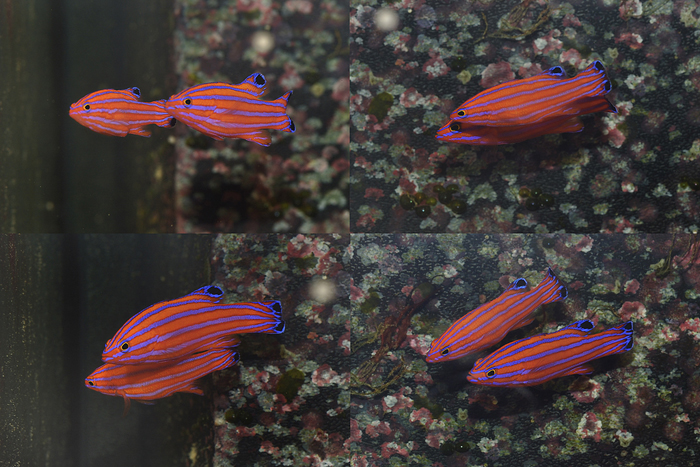
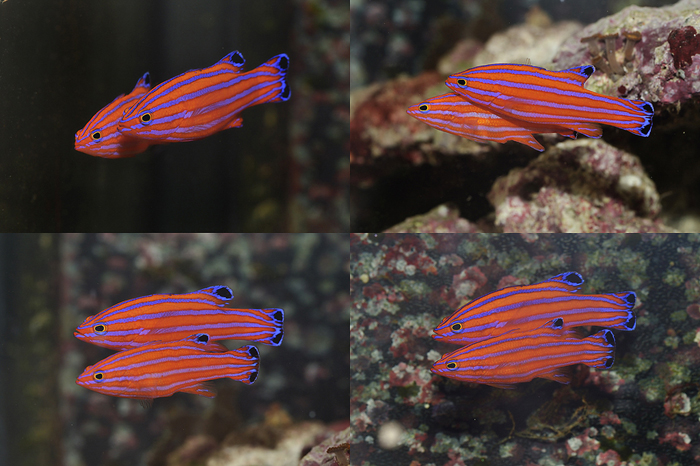 Photographing under such low light conditions, in a tank lit only by the room lighting proved to be quite a challenge. Focusing in low light is not easy. Using the camera’s internal focus assist light, was spooking the fish and causing them to hide. Using the flash was not easy as it was resulting in a lot of glare. I had to go to an off camera flash. Initial attempts resulted in scaring the fish, but after a few days and my continued attempts at trying to photograph the fish I finally had a good handle on a workable technique that would yield good results. In the meantime, I guess the natural sex drive of the fish over took the camera shyness and it became less of an issue.
Photographing under such low light conditions, in a tank lit only by the room lighting proved to be quite a challenge. Focusing in low light is not easy. Using the camera’s internal focus assist light, was spooking the fish and causing them to hide. Using the flash was not easy as it was resulting in a lot of glare. I had to go to an off camera flash. Initial attempts resulted in scaring the fish, but after a few days and my continued attempts at trying to photograph the fish I finally had a good handle on a workable technique that would yield good results. In the meantime, I guess the natural sex drive of the fish over took the camera shyness and it became less of an issue.
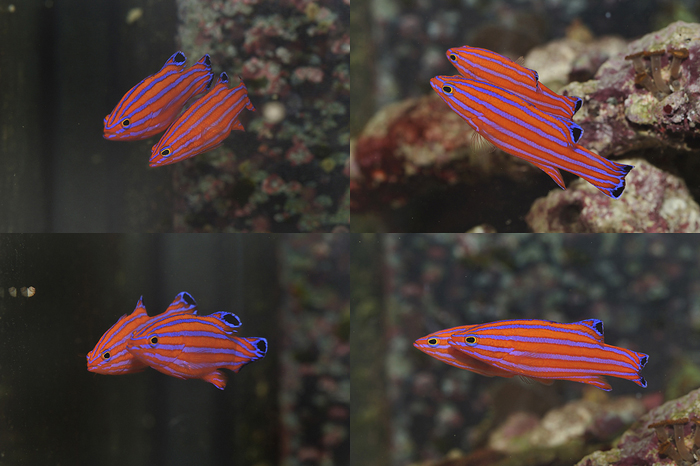
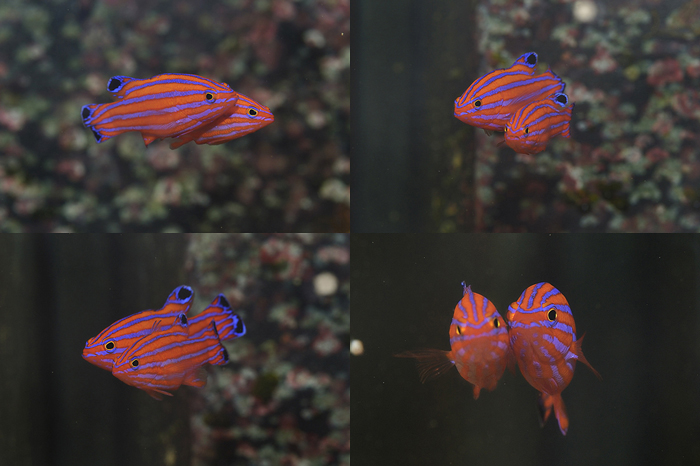 After a few nights of successful photography, I decided to try to video tape the courtship. Video taping under these low conditions was itself quite challenging. The 40W incandescent lamp in the room was the only light I had to go by given that they would only go through the courtship under these lights. I was not sure if stronger light would disturb the courtship and prevent spawning. After a few failed attempts to see any spawning I got lucky and caught what I think is a possible spawn at the end of the courtship. Sitting late into the nights with a video camera in hand finally paid off!!
After a few nights of successful photography, I decided to try to video tape the courtship. Video taping under these low conditions was itself quite challenging. The 40W incandescent lamp in the room was the only light I had to go by given that they would only go through the courtship under these lights. I was not sure if stronger light would disturb the courtship and prevent spawning. After a few failed attempts to see any spawning I got lucky and caught what I think is a possible spawn at the end of the courtship. Sitting late into the nights with a video camera in hand finally paid off!!
UPDATE: There must be something in the air with this coveted species. Subsequent to this writing as reported in Reefs.com The Long Island Aquarium’s Todd Gardner has succeeded in spawning, and raising L. carmabi larvae though settlement for the first time. With any luck, the dream of captive-bred Candy Basslets will not be a dream for much longer.



0 Comments